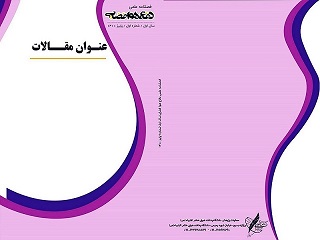[1] S. Shiyab, “Phytoaccumulation of copper from irrigation water and its effect on the internal structure of lettuce”, Agriculture Vol. 8(2), p.29,2018.
[2] J. F. Collins, “Copper nutrition and biochemistry and human (patho)physiology”, Advances in Food and Nutrition Research, Elsevier pp 311–364, 2021.
[3] S. Jena, S. Tripathy, N. Mandre, R. Venugopal, S. Farrokhpay, “Sustainable Use of Copper Resources: Beneficiation of Low-Grade Copper Ores”, Minerals, MDPI AG. Vol. 12(5), pp. 545, 2022.
[4] Q. Han, X. Yang, Y. Huo, J. Lu, Y. Liu, “Determination of ultra-trace amounts of copper in environmental water samples by dispersive liquid-liquid microextraction combined with graphite furnace atomic absorption spectrometry”, Separations, Vol. 10(2), p. 93, 2023.
[5] M. afati Rahimzadeh, S. Kazemi, A. A. Moghadamnia, “Copper Poisoning with Emphasis on Its Clinical Manifestations and Treatment of Intoxication”, A. U. Rauf (Ed.), Advances in Public Health, Vol. 2024, pp. 1–12, 2024.
[6] S. Kucukkolbasi, S. Sayin, M. Yilmaz, “Fabrication and application of a new modified electrochemical sensor using newly synthesized calixarene-grafted MWCNTs for simultaneous determination of Cu (II) and Pb (II) ”, Acta Chimica Slovenica, Vol. 66(4), pp. 839-849, 2019.
[7] A.S. Amin, M.Y. Nassar, A. Gomaa, “Utility of solid-phase extraction coupled with spectrophotometry for a novel green nano determination of copper (II) using 4-((furan-2-ylmethylene) amino)-5-methyl-4H-1, 2, 4-triazole-3-thiol, Int. J. Environ. Anal. Chem”, Vol.103(7), pp1550-1571, 2023.
[8] E. Raafid, M.A. Al-Da’amy, S.H. Kadhim, “Spectrophotometric determination of Cu (II) in analytical sample using a new chromogenic reagent (HPEDN) ”, Indonesian Journal of Chemistry. Vol. 20(5), pp.1080-1091, 2020.
[9] N. Verma, A.K. Singh, M. Singh, “L-arginine biosensors: A comprehensive review”, Biochemistry and biophysics reports, Vol. 12, pp. 228-239, 2017.
[10] M. Ginésy, J. Enman, D. Rusanova-Naydenova, U. Rova, “Simultaneous quantification of L-Arginine and monosaccharides during fermentation: an advanced chromatography approach”, Molecules, Vol. 24(4), p.802, 2019.
[11] A.-A. Martí i Líndez, W. Reith, “Arginine-dependent immune responses.”, Cellular and Molecular Life Sciences , Springer Science and Business Media LLC., Vol. 78(13), pp. 5303–5324, 2021.
[12] N. Kurhaluk, “The Effectiveness of L-arginine in Clinical Conditions Associated with Hypoxia”, International Journal of Molecular Sciences, MDPI AG., Vol. 24(9), pp. 8205, 2023.
[13] B.M. Costa, A.A. Prado, T.C. Oliveira, L.P. Bressan, R.A. Munoz, A.D. Batista, J.A. da Silva, E.M. Richter, “Fast methods for simultaneous determination of arginine, ascorbic acid and aspartic acid by capillary electrophoresis”, Talanta, Vol. 204, pp.353-358, 2019.
[14] A.A. do Prado, M.M.A.C. Ribeiro, E.M. Richter, “Ultra rapid capillary zone electrophoresis method for simultaneous determination of arginine and ibuprofen”, Journal of Separation Science, Vol. 44(13), pp. 2596-2601, 2021.
[15] H.A. Matar, M.A. Ibrahim, M. El-Hagary, “Simple and cost-effective route for PANI-ZnO-rGO nanocomposite as a biosensor for L-arginine detection”, Diamond and Related Materials, Vol.133, pp.109-703, 2023.
[16] A.K. Singh, R. Sharma, M. Singh, N. Verma, “Electrochemical determination of L-arginine in leukemic blood samples based on a polyaniline-multiwalled carbon nanotube—magnetite nanocomposite film modified glassy carbon electrode”, Instrumentation Science & Technology, Vol. 48(4), pp.400-416, 2020.
[17] X. Bu, Y. Fu, X. Jiang, H. Jin, R. Gui, “Self-assembly of DNA-templated copper nanoclusters and carbon dots for ratiometric fluorometric and visual determination of arginine and acetaminophen with a logic-gate operation”, Microchimica Acta, Vol.187, pp.1-10, 2020
[18] P. Marimuthu, A. Ramu, “Sensitivity and Selectivity of Fluorescent Chemosensor for the Detection of Fe 3+ and its Cell Images”, 2022.
[19] L. Zeußel, P. Mai, S. Sharma, A. Schober, S. Ren, S. Singh, “Colorimetric Method for Instant Detection of Lysine and Arginine Using Novel Meldrum's Acid Furfural Conjugate”, ChemistrySelect, Vol. 6(27), pp. 6834-6840, 2021.
[20] S. Zhang, J. Jing, L. Meng, B. Xu, X. Ma, W. Tian, “Peptide-Conjugated Aggregation-Induced Emission Fluorogenic Probe for Glypican-3 Protein Detection and Hepatocellular Carcinoma Cells Imaging”, Chemosensors,Vol. 10(5), p.195, 2022.
[21] Y. Liu, X. Wang, E. Feng, C. Fan, S. Pu, “A highly selective sequential recognition probe for Zn2+ and HSO4−/H2PO4− based on a diarylethene chemosensor”, SAA, Vol.246, No.119052, 2021.
[22] H. Tavallali, G. Deilamy-Rad, N. Mosallanejad, “Razvoj novog kolorimetrijskog kemijskog senzora za selektivno određivanje koncentracije oksalata u urinu i povrću pomoću metode istiskivanja indikatora (IDA) ”, Food Technol. Biotechnol, Vol.56(3), pp. 329-336. 2018.
[23] H. Tavallali, A. Parhami, S. Rajaei Dastghaib, M. A. Karimi, “I A novel and simple naphthol azo dye chemosensor as a naked eye detection tool for highly selective, sensitive and accurate determination of thiourea in tap water, juices and fruit skins”, pectrochimica Acta Part A: Molecular and Biomolecular Spectroscopy,Vol. 289, pp. 22194, 2023.
[24] H. Tavallali, G. Deilamy-Rad, A. Moaddeli, K. Asghari, “Indigo Carmine-Cu complex probe exhibiting dual colorimetric/fluorimetric sensing for selective determination of mono hydrogen phosphate ion and its logic behavior”, SAA,Vol. 183, pp. 319-331, 2017.
[25] H. Tavallali, G. Deilamy-Rad, A. Parhami, K. Asghari, A. Ahmadi, “Bismuth triggered selective colorimetric naked-eye detection for oxalate ions based on bromopyrogallol red that works as a molecular keypad lock”, Int. J. Environ. Anal. Chem, Vol.101(5), pp. 648-667, 2021.
[26] H. Tavallali, G. Deilamy-Rad, A. Moaddeli, K. Asghari, “A new pincer-type “naked-eye” colorimetric probe for Cu+ 2 determination in 80% water media and its application as a solid state sensor and an efficient antibacterial product”, Sens. Actuators B Chem, Vol.244, pp. 1121-1128, 2017.
[27] H. Tavallali, G. Deilamy-Rad, N. Mosallanejad, “Reactive blue 4 as a Single colorimetric chemosensor for sequential determination of multiple analytes with different optical responses in aqueous media: Cu 2+-cysteine using a metal ion displacement and Cu 2+-arginine through the host-guest interaction”, Appl. Biochem. Biotechnol, Vol.187, pp. 937-913, 2019.
[28] H. Tavallali, G. Deilamy-Rad, N. Mosallanejad, “A reversible and dual responsive sensing approach for determination of ascorbate ion in fruit juice”, biological, and pharmaceutical samples by use of available triaryl methane dye and its application to constructing a molecular logic gate and a set/reset memorized device, SAA, Vol. 215, pp. 276-289, 2019.
[29] H. Tavallali, G. Deilamy-Rad, A. Parhami, M. Heidari, N. Mosllanejad, “A developed chromogenic probe for determination of dual analyte with logic gates function and keypad-lock”, Int. J. Environ. Anal. Chem, Vol.101(4), pp. 433-449, 2021.
[30] H. Tavallali, G. Deilamy-Rad, M.A. Karimi, M.-A. Aameri-Siahooei, “A novel sensitive and fast colorimetric assay for determination of benzidine as a carcinogen aromatic amine based on Bromopyrogallol red”, Int. J. Environ. Anal. Chem, Vol.100(6), pp. 662-674, 2020.
[31] H. Tavallali, A. Parhami, M.A. Karimi, P. Hossein-Khezri, “Simultaneous detection of SO32-and PO43-anions, in aqueous solutions based on 4-(2-Pyridylazo) resorcinol (PAR) as a colorimetric chemosensor and analytical applications”, Int. J. Environ. Anal. Chem. Vol. 102(15), pp. 3652-3671, 2022.
[32] G. Deilamy-Rad, K. Asghari, H. Tavallali, “Development of a reversible indicator displacement assay based on the 1-(2-Pyridylazo(2-naphthol for colorimetric determination of cysteine in biological samples and its application to constructing the paper test strips and a molecular-scale set/reset memorized device”, Appl. Biochem. Biotechnol, Vol.192, pp. 85-102, 2020.
[33] H. Tavallali, O. Espergham, G. Deilamy-Rad, M.A. Karimi, S. Rostami, “A.-R. Rouhani-Savestani, Dye/metal ion-based chemosensing ensemble towards l-histidine and l-lysine determination in water via different optical responses”, Anal. Biochem, Vol. 604, No. 113811, 2020.
[34] H. Tavallali, E. Rahimi, G. Deilamy,Rad, M.A. Karimi, M. Tavallali, “A novel colorimetric chemosensor for selective and highly sensitive determination of thiourea: An approach toward a molecular keypad lock”, J. Chin. Chem. Soc, Vol. 68(7), pp. 1279-1290, 2021.
[35] B A. Burakov, E. Neskoromnaya, A. Babkin, “Removal of the Alizarin Red S Anionic Dye Using Graphene Nanocomposites: A study on Kinetics under Dynamic Conditions”, Materials Today: Proceedings Elsevier BV., Vol. 11, pp. 392–397, 2019.
[36] J L. L. G. Justino, S.. Braz, M. L.. Ramos, “Spectroscopic and DFT Study of Alizarin Red S Complexes of Ga(III) in Semi-Aqueous Solution”, Photochem, MDPI AG. Vol. 3(1), pp. 61–81, 2023.
[37] N. Tanjila, M. Ahsan, S. Ben Aoun, I. A. Siddiquey, S. S. Alam, M. A. Hasnat “An Electrochemical Approach to As(V) Determination via an Interaction with Alizarin Red S in Aqueous Medium.”, Journal of Analytical Chemistry, Pleiades Publishing Ltd, Vol. 76(12), pp. 1449–1454, 2021.
[38] H.A. Benesi, J. Hildebrand, “A spectrophotometric investigation of the interaction of iodine with aromatic hydrocarbons”, J. Am. Chem. Soc, Vol.71(8) pp.2703-2707, 1949.
[39] Naeini, Ali Hosseinian, and Seyed Ali Hosseini Moradi. "Adsorption Method for Removal of Pharmaceuticals from Wastewater." Iranian Journal of Materials Science & Engineering 20.4 (2023).
[40] A.M.A. Rahim, A.A.A. Gaber, E.M. Mahmoud, “Fabrication and characterization of extrinsic electrochemically modified graphite reinforcement carbon paste electrode for selective determination of Cu (II) in trace levels”, Applied Surface Science Advances, Vol. 2, No. 100031, 2020.

